Sicily is the land of legends temples and amphitheaters. Its culture is a fusion of its past conquerors: Greek, Roman, Byzantine, Arab, Norman, Spanish. The layered history reflects in the growth and change of each century. Many of its most alluring villages stand over ancient ruins. These influences, with the character of the Sicilians themselves give entire island a unique identity in art, architecture and especially food. The blending of styles makes the region so memorable to me, and keeps me coming back to find something new yet to discover.
Another influence through the ages is seismic. Earthquakes and volcanic activity have impacted on its towns and villages. A “Sicilian Baroque” style emerged after the great earthquake in 1693. The land varies greatly from dramatic coastal shores to the rugged mountains to Mount Etna, an active volcano. Driving in Sicily means driving over bridges and through many tunnels. The real joy of Sicily is in discovering its special historical places, its stories and mythology that reveal its essence, where a succession of civilizations left their indelible impression and made it a unique island unlike any other.
Driving in Sicily is especially satisfying because the diverse cultural centers are spread out, and the well-constructed autostrada is pretty free of traffic outside of the larger cities. The entire island is about the size of Vermont and overflowing with UNESCO World Heritage sites. One of my favorite natural features are the olive groves and vineyards Each area has its own unique vibe. The tour I enjoy most starts in Palermo and finishes in Cefalu.
Palermo can be reached any number of ways. I have taken the train from Rome (not recommended, and you get a strange look from any Sicilian that you tell about it), the ferry, and flown. From the Italian boot, my preferred way to travel there has been by ferry from the port of Naples.
 We took an overnight ferry and slept in a premium exterior compartment with two twin beds and a small bathroom with a shower. You can sightsee all day in Naples or other Italian coastal town then cast off from the port in the evening. The ferry terminal (in fact, every ferry terminal we have been to in Italy) can be hectic in the hour before departure, so leave yourself plenty of time. You may think you have a ticket for the ferry which you have purchased online, it is an important to check at the ship ticketing office to make sure what you have will be accepted when you try to board.
We took an overnight ferry and slept in a premium exterior compartment with two twin beds and a small bathroom with a shower. You can sightsee all day in Naples or other Italian coastal town then cast off from the port in the evening. The ferry terminal (in fact, every ferry terminal we have been to in Italy) can be hectic in the hour before departure, so leave yourself plenty of time. You may think you have a ticket for the ferry which you have purchased online, it is an important to check at the ship ticketing office to make sure what you have will be accepted when you try to board.
 You can pack something to eat during the trip, or get a bite in a sensible restaurant on board or just grab a sandwich or snack and return to your cabin. For me it is a good way to get there without wasting a lot of waking time.
You can pack something to eat during the trip, or get a bite in a sensible restaurant on board or just grab a sandwich or snack and return to your cabin. For me it is a good way to get there without wasting a lot of waking time.
On arriving in Palermo, you can take a taxi to your accommodation or to a rental car outlet to head elsewhere. We have had good and bad experiences with taxis in Italy, not many good ones in Palermo. Be sure to ask your taxi driver the cost to get where you are headed before you get into the cab, and don’t take “don’t worry about it for an answer.
Click on thumbnails to view larger images
Palermo
Palermo is Sicily’s largest city and its capital (population ~700,000). It is an active port city surrounded by mountains. The many civilizations that shaped Sicily are evident as you tour this vibrant multifaceted city. It has a glorious, gritty, grandeur. Some areas could use some loving care, renovations and overall upkeep but there is soul in its quirky edginess which to me is part of its enduring charm.
Driving in Palermo, or in any large European city, is not recommended. On our visits, we see the city on foot or public transportation, and pick up a rental car when we leave to see the rest of the island. Parking is tricky and the vespa riders could drive you crazy with their unpredictable maneuvers. I have noticed particularly in the southern part of Italy a very different type of driver, who often disregards universal traffic laws and sometimes gives you the feeling that it is “every man for himself.” It can be particularly daunting but for some is well worth the adventure.
Some of the highlights and best things to do are:
Ballero Market: a great place to view local traditions and culture. Perhaps the oldest of Palermo’s “Arabic markets,” it has a bit of a souk-like atmosphere. Salesmen sing and hawk their wares. Lots of fresh fish and vegetables, bars, street food vendors and entertainment throughout the day.
 Palermo Cathedral: UNESCO World Heritage Site, a fascinating spiritual space with a unique combination of architectural styles built over the span of more than 1,500 years. The spiral stairs at the west end of the cathedral lead up to a bell tower and to a roof-top space that has remarkable views of the city.
Palermo Cathedral: UNESCO World Heritage Site, a fascinating spiritual space with a unique combination of architectural styles built over the span of more than 1,500 years. The spiral stairs at the west end of the cathedral lead up to a bell tower and to a roof-top space that has remarkable views of the city.
 Norman Palace: This is a UNESCO World Heritage Site, a palace of kings and rulers since the Arabs built it in the 9th Century. It is surrounded by a large park, and currently occupied by Sicily’s regional parliament. Part of the building is open for public viewing. One of the most important parts of the palace is the Palatine Chapel, which was completed in 1142. It is a masterpiece of Arab, Byzantine and Norman design at its very best. Not to be missed!
Norman Palace: This is a UNESCO World Heritage Site, a palace of kings and rulers since the Arabs built it in the 9th Century. It is surrounded by a large park, and currently occupied by Sicily’s regional parliament. Part of the building is open for public viewing. One of the most important parts of the palace is the Palatine Chapel, which was completed in 1142. It is a masterpiece of Arab, Byzantine and Norman design at its very best. Not to be missed!
 Teatro Massimo: largest opera house in Italy, third largest in Europe. There is a wonderful apartment which overlooks the opera house. See a room with a view.
Teatro Massimo: largest opera house in Italy, third largest in Europe. There is a wonderful apartment which overlooks the opera house. See a room with a view.
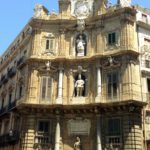 Quatro Conti (“four corners”): Beautiful 17th Century Baroque buildings where four historical districts come together. Nice walkable area where two major city streets intersect. It is considered the central part of the old town.
Quatro Conti (“four corners”): Beautiful 17th Century Baroque buildings where four historical districts come together. Nice walkable area where two major city streets intersect. It is considered the central part of the old town.
 Capuchin Catacombs: unforgettably haunting look at the mummified dead placed on walls in their finest attire after death. Monks and the wealthy were the only ones that were afforded this unique luxury. Maybe a bit too strong for small children. Is one of my favorite stops in Palermo. See Sacred Spaces for details.
Capuchin Catacombs: unforgettably haunting look at the mummified dead placed on walls in their finest attire after death. Monks and the wealthy were the only ones that were afforded this unique luxury. Maybe a bit too strong for small children. Is one of my favorite stops in Palermo. See Sacred Spaces for details.
Segesta
 Segesta is about 45 miles southwest of Palermo, and well worth a detour on the road to Trapani/Erice. It is located in the mountains on the edge of a canyon. The 5th Century ruins glow bewitchingly in golden stone. It is one of the best-preserved examples of a Greek Doric temple which looks perfectly situated in a lush rural setting. There is also a Greek Roman amphitheater as well as other ruins from different periods in the area nearby.
Segesta is about 45 miles southwest of Palermo, and well worth a detour on the road to Trapani/Erice. It is located in the mountains on the edge of a canyon. The 5th Century ruins glow bewitchingly in golden stone. It is one of the best-preserved examples of a Greek Doric temple which looks perfectly situated in a lush rural setting. There is also a Greek Roman amphitheater as well as other ruins from different periods in the area nearby.
Marsala
 After the Segesta stop, you can drive about 20 miles to Trapani/Erice area or go on to Marsala (about 30 miles from Segesta) for dinner and to relax for the night. It is a great base for exploring the southwest corner of Sicily. I thoroughly enjoyed staying in Marsala’s old town for the pleasant morning and evening walks in the historical district, and for its choices for breakfast and dinner. See a Room with a View for a great place to stay.
After the Segesta stop, you can drive about 20 miles to Trapani/Erice area or go on to Marsala (about 30 miles from Segesta) for dinner and to relax for the night. It is a great base for exploring the southwest corner of Sicily. I thoroughly enjoyed staying in Marsala’s old town for the pleasant morning and evening walks in the historical district, and for its choices for breakfast and dinner. See a Room with a View for a great place to stay.
The streets in reaching the old town are narrow and can be a little tricky to maneuver by car. There is a public lot where we parked each night, about a 5-minute walk to the old town. Like many towns and villages in Sicily, the old historical part can be hidden behind less attractive buildings, but once you hit the old town it is delightful.
Trapani
 Trapani’s Old Town is at the western tip of Sicily against the sea. The areas surrounding the old town are newer, rebuilt after the bombings during World War II. The character of the Old Town is mostly Medieval, as traces of the most ancient conquerors are now gone. It is a lovely walkable area especially at the shore, where the stand outs are Torre del Ligny and Torre della Colombaia (towered fortresses), Cathedral di San Lorenzo and Chiesa Anime Sante del Purgatorio (“church of purgatory”) Similar motif as the church of purgatory in Monopoli without mummified clergyman. You can park your car just outside the Old Town walls.
Trapani’s Old Town is at the western tip of Sicily against the sea. The areas surrounding the old town are newer, rebuilt after the bombings during World War II. The character of the Old Town is mostly Medieval, as traces of the most ancient conquerors are now gone. It is a lovely walkable area especially at the shore, where the stand outs are Torre del Ligny and Torre della Colombaia (towered fortresses), Cathedral di San Lorenzo and Chiesa Anime Sante del Purgatorio (“church of purgatory”) Similar motif as the church of purgatory in Monopoli without mummified clergyman. You can park your car just outside the Old Town walls.
To go to Erice, you can repark (a bit too far to walk unless you do not mind a pretty dull 40-minute walk) near the cable car station, or Erice. I have approached the city both ways, and much prefer the cable car, as the road up to Erice takes about 30 minutes on a twisting turning narrow road. That drive does offer panoramic photo ops. The cable car ride also has an incredible view of the sea and Trapani, and is about 10 to 15-minutes each way. It was open in late November while I was there. It is closed if the weather is windy or stormy.
Erice
 Erice, located about 750 meters above the sea, has a magical, ethereal atmosphere. It is a walled medieval hill town with ancient historical roots. It was originally inhabited by the Elymians, who were early natives of Sicily. They were followed by Greeks, Carthaginians, Romans, Arabs, Normans and Spaniards. So, it is a unique blend of cultural traditions. It is well known for its historic churches and convents. There is also a spectacular fortress well worth a visit. One of the remarkable sites is the Castello di Venere, a Norman castle built over an earlier temple of Venus. You are no longer able to go inside the castle but the exterior garden is full of scenic views looking out to sea. The Duomo is also interesting, and its campanile (tower) has impressive views. Two other churches to visit are Chiesa di San Giuliano and Chiesa di San Martino.
Erice, located about 750 meters above the sea, has a magical, ethereal atmosphere. It is a walled medieval hill town with ancient historical roots. It was originally inhabited by the Elymians, who were early natives of Sicily. They were followed by Greeks, Carthaginians, Romans, Arabs, Normans and Spaniards. So, it is a unique blend of cultural traditions. It is well known for its historic churches and convents. There is also a spectacular fortress well worth a visit. One of the remarkable sites is the Castello di Venere, a Norman castle built over an earlier temple of Venus. You are no longer able to go inside the castle but the exterior garden is full of scenic views looking out to sea. The Duomo is also interesting, and its campanile (tower) has impressive views. Two other churches to visit are Chiesa di San Giuliano and Chiesa di San Martino.
In the fall season the streets of Erice are particularly quiet. Walking the peaceful town evokes the magic of ancient settings from centuries before. Although the choices for shopping and eating can be limited this time of year, we had no problem finding a fine restaurant for lunch, and a number of open shops. We absolutely loved visiting a village so steeped in historical significance, free of the throngs of in-season tourists.
Agrigento
 Sicily’s most renowned Greek ruins are the Valley of the Temples and are a UNESCO World Heritage Site, and a must-see for anyone interested in Ancient Greek architecture and antiquities. The temples were built in the 5th and 6th centuries BC. The most dramatic view is to drive in from the south, seaward direction with the hilltop village behind the temples. The view from the modern part of the town of Agrigento also has some great views of the temples with the sea in the distance. These are unforgettable vistas. The setting for the temples is a pleasant rural area of open fields and orchards. A large ancient garden has been brought back to life between two of the temples. There are eight temples in all and plenty of other artifacts spread over the whole archeological park. There is also a good archeological museum in town which describes the history and culture of the site.
Sicily’s most renowned Greek ruins are the Valley of the Temples and are a UNESCO World Heritage Site, and a must-see for anyone interested in Ancient Greek architecture and antiquities. The temples were built in the 5th and 6th centuries BC. The most dramatic view is to drive in from the south, seaward direction with the hilltop village behind the temples. The view from the modern part of the town of Agrigento also has some great views of the temples with the sea in the distance. These are unforgettable vistas. The setting for the temples is a pleasant rural area of open fields and orchards. A large ancient garden has been brought back to life between two of the temples. There are eight temples in all and plenty of other artifacts spread over the whole archeological park. There is also a good archeological museum in town which describes the history and culture of the site.
Piazza Amerina
 Piazza Amerina, a UNESCO World Heritage Site, is a historic town in the heart of Sicily not far from Agrigento. It is most famous for the Villa Romana del Casale a luxury Roman villa most known for its large and well-preserved collection of Roman mosaics. The mosaics are artful and intricate, and well worth seeing. The walkways around the villa are rather narrow, and easily crowd when tourists visit en masse. The lighting for seeing the site is usually best in the morning. You get a real feeling for what a luxury home was like in 4th century AD and what each room was used for.
Piazza Amerina, a UNESCO World Heritage Site, is a historic town in the heart of Sicily not far from Agrigento. It is most famous for the Villa Romana del Casale a luxury Roman villa most known for its large and well-preserved collection of Roman mosaics. The mosaics are artful and intricate, and well worth seeing. The walkways around the villa are rather narrow, and easily crowd when tourists visit en masse. The lighting for seeing the site is usually best in the morning. You get a real feeling for what a luxury home was like in 4th century AD and what each room was used for.
Ragusa/Modica/Noto/Syracusa Area
The 1693 earthquake ravages these towns and other villages across southeastern Sicily. They were rebuilt in a late Sicilian Baroque style and all are UNESCO World Heritage Sites. I would recommend any of them as a base for exploring this section of Sicily. I opted for Modica and really enjoyed the charming apartment with the most amazing panoramic views. See a room with a view. I would have enjoyed any of the other villages equally as well. This whole area is a particular favorite of mine because the architecture is simply dazzling and you will not find anything like it anywhere else in the world.
Ragusa
 As in most Sicilian towns, a modern part of town (Ragusa Superiore) with more contemporary buildings abuts the historic old town (Ragusa Ibla). The Old Town is beautiful to walk to experience the maze of narrow streets and alleyways with ornate balconies. Walks tend to end up in the main central square, Piazza Duomo. This town is a great place to get a drink or eat near the Duomo. The Duomo San Giorgio and the Museo del duomo are interesting sites too.
As in most Sicilian towns, a modern part of town (Ragusa Superiore) with more contemporary buildings abuts the historic old town (Ragusa Ibla). The Old Town is beautiful to walk to experience the maze of narrow streets and alleyways with ornate balconies. Walks tend to end up in the main central square, Piazza Duomo. This town is a great place to get a drink or eat near the Duomo. The Duomo San Giorgio and the Museo del duomo are interesting sites too.
Modica
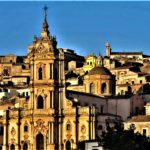 On first approaching Modica, you encounter newer construction, with everyday apartment, and business life. As you drive through the outer city, the beautiful streets of the old town appear, and the historical district really shines. Parking is relatively inexpensive. You pay for blocks of time in convenience stores and lay the ticket on your dashboard and park on the streets. Modica’s old town is an upper level of churches and residences for which you must climb stairs, and a lower area of restaurants, cafes and shops. When you walk up into the upper levels there are amazing views of historic structures, built one upon another: churches, domes, clock towers, all mixed into a giant mosaic. It reminds me a bit of Matera in southern Italy. The narrow streets head skyward and one you get to the top the view of town is remarkable. I stayed in a charming apartment in Modica with some of the most incredible views from the bedroom, the patio and a small balcony where you can sit and enjoy coffee or a glass of wine. See a room with a view.
On first approaching Modica, you encounter newer construction, with everyday apartment, and business life. As you drive through the outer city, the beautiful streets of the old town appear, and the historical district really shines. Parking is relatively inexpensive. You pay for blocks of time in convenience stores and lay the ticket on your dashboard and park on the streets. Modica’s old town is an upper level of churches and residences for which you must climb stairs, and a lower area of restaurants, cafes and shops. When you walk up into the upper levels there are amazing views of historic structures, built one upon another: churches, domes, clock towers, all mixed into a giant mosaic. It reminds me a bit of Matera in southern Italy. The narrow streets head skyward and one you get to the top the view of town is remarkable. I stayed in a charming apartment in Modica with some of the most incredible views from the bedroom, the patio and a small balcony where you can sit and enjoy coffee or a glass of wine. See a room with a view.
Noto
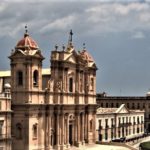 This jewel was rebuilt in the ornate late Sicilian Baroque style after the earthquake of 1693. It has a beautiful, elaborate historic center. One of the most exquisite pathways is Corso Vittorio Emanuele, which is full of shops and cafés, and is the major shopping area in the historic center. Some nearby attractions are Noto Cathedral, and Piazza dell’Immacolata Via Nicolaci. It is pleasant just to walk the Baroque streets and enjoy a beautiful meal in a café at sunset. The hour before dusk brings out the luminous glory of the town and its buildings
This jewel was rebuilt in the ornate late Sicilian Baroque style after the earthquake of 1693. It has a beautiful, elaborate historic center. One of the most exquisite pathways is Corso Vittorio Emanuele, which is full of shops and cafés, and is the major shopping area in the historic center. Some nearby attractions are Noto Cathedral, and Piazza dell’Immacolata Via Nicolaci. It is pleasant just to walk the Baroque streets and enjoy a beautiful meal in a café at sunset. The hour before dusk brings out the luminous glory of the town and its buildings
Syracusa
 Syracusa is full of history and dramatic coastal beauty. It was founded about 734 BC by the Corinthians, and for a time was one of the most powerful Greek cities in the Mediterranean. Its architectural styles very greatly: Greek, Roman, Norman with medieval and baroque influences. Ortigia is the old town, located on an island which can be reached by two road bridges. The charm is in wandering its labyrinth of cobbled pathways with baroque iron balconies, and scenic piazzas. The Piazza del Duomo is especially memorable, and a great place to stop for a meal or have a drink. It is the chief gathering place of the town with a mixture of architectural styles. Sights of interest are Temple of Apollo, the Syracusa market, the harbor, Castello Maniace, Neopolis archaeological park (which includes a Roman amphitheater), a huge Greek theater with an impressive harbor view, and the Garden of Paradise. The ironically named Garden was a former slave quarters and stone quarry with a macabre history. It is now a tree filled garden. There are many sites to be explored, so you may want to spend more time in this truly memorable city.
Syracusa is full of history and dramatic coastal beauty. It was founded about 734 BC by the Corinthians, and for a time was one of the most powerful Greek cities in the Mediterranean. Its architectural styles very greatly: Greek, Roman, Norman with medieval and baroque influences. Ortigia is the old town, located on an island which can be reached by two road bridges. The charm is in wandering its labyrinth of cobbled pathways with baroque iron balconies, and scenic piazzas. The Piazza del Duomo is especially memorable, and a great place to stop for a meal or have a drink. It is the chief gathering place of the town with a mixture of architectural styles. Sights of interest are Temple of Apollo, the Syracusa market, the harbor, Castello Maniace, Neopolis archaeological park (which includes a Roman amphitheater), a huge Greek theater with an impressive harbor view, and the Garden of Paradise. The ironically named Garden was a former slave quarters and stone quarry with a macabre history. It is now a tree filled garden. There are many sites to be explored, so you may want to spend more time in this truly memorable city.
Mount Etna and Cantania
 I have not yet visited either of these sites, but plan to stop for lunch and sightseeing on my next trip. If you choose to go to Mount Etna, staying in Cantania will make the trip easier. Etna is Europe’s most active volcano. You can drive to the cable car station at 6,200 feet. The cable car brings you to 8,000 feet. After that you must take an all-terrain vehicle to the top. The cable car and vehicle are about 60 Euros per person. It is open year around. I chose instead to head to Taormina since I lived in Indonesia for a time and had seen my share of volcanoes.
I have not yet visited either of these sites, but plan to stop for lunch and sightseeing on my next trip. If you choose to go to Mount Etna, staying in Cantania will make the trip easier. Etna is Europe’s most active volcano. You can drive to the cable car station at 6,200 feet. The cable car brings you to 8,000 feet. After that you must take an all-terrain vehicle to the top. The cable car and vehicle are about 60 Euros per person. It is open year around. I chose instead to head to Taormina since I lived in Indonesia for a time and had seen my share of volcanoes.
Taormina
 High above the Ionian Sea in the shadow of Mount Eta sits the beautiful hill town of Toarmina, a Greek/Roman settlement founded about 858 BC. It is strikingly situated on the side of a mountain. Parking is usually difficult in mountain-side towns, but Taormina has a large multi-level parking garage at the entrance to town. It is reasonably priced and convenient to the town center. Such convenience is rare in most other towns in Sicily.
High above the Ionian Sea in the shadow of Mount Eta sits the beautiful hill town of Toarmina, a Greek/Roman settlement founded about 858 BC. It is strikingly situated on the side of a mountain. Parking is usually difficult in mountain-side towns, but Taormina has a large multi-level parking garage at the entrance to town. It is reasonably priced and convenient to the town center. Such convenience is rare in most other towns in Sicily.
 Like the rest of Sicily there were also the Byzantines, Arab, Norman and the Spanish and French influences. Most of the architecture is a restored medieval style. The 3rd Century BC Teatro Greco boasts spectacular views of the sea, the town and the island of Isola Bella. Isola Bella can be reached by cable car in Taormina. The island was once privately-owned, but it is now a nature preserve opened to the public. It is known for its rocky beach with exquisitely clear water.
Like the rest of Sicily there were also the Byzantines, Arab, Norman and the Spanish and French influences. Most of the architecture is a restored medieval style. The 3rd Century BC Teatro Greco boasts spectacular views of the sea, the town and the island of Isola Bella. Isola Bella can be reached by cable car in Taormina. The island was once privately-owned, but it is now a nature preserve opened to the public. It is known for its rocky beach with exquisitely clear water.
Corso Umberto is the main street of Taormina. There are a variety of shops from high-end antiques and jewelry to the typical souvenir shop. I collect cameos and this is one of the best places in Sicily to find them. The restaurants feature lots of fresh fish and of course pizza and pasta. There are also narrow side streets off Corso Umberto, up stairways, full of interesting restaurants. I stayed in a lovely villa right off Corso Umberto with stunning views of the Teatro, Mount Etna and the Sea. See a room with a view.
Some of the other key spots are: Palazzo Corvaja, an interesting medieval palace dating from the 10th Century, and Duomo di San Nicola, a lovely medieval church built over an earlier church; it looks a bit like a fortress. Chiesa di San Pancrazio, built over what was originally a Greek temple, is a charming Baroque style church. Odeon is a nearly hidden small Roman theater behind the Santa Catarina church. And for garden lovers, the Villa Comunale is an exquisitely designed English garden mixed with tropical plants.
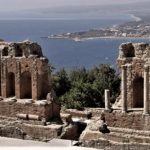 A 20-minute hike from the city brings you to the top of Monte Tauro. The steep climb is well worth the scenic views over Teatro Greco, Taormina and beyond. There is also a tiny church close by founded around 1640. According to legend the Virgin Mary and baby Jesus appeared to a shepherd who had taken refuge in a grotto there during a storm. The church terrace also features of panoramas of Taormina and the Ionian Sea.
A 20-minute hike from the city brings you to the top of Monte Tauro. The steep climb is well worth the scenic views over Teatro Greco, Taormina and beyond. There is also a tiny church close by founded around 1640. According to legend the Virgin Mary and baby Jesus appeared to a shepherd who had taken refuge in a grotto there during a storm. The church terrace also features of panoramas of Taormina and the Ionian Sea.
Taormina is a highly-touristed town, with folks from all over the world. It is particularly popular with Italians from the mainland. I love the late fall here as the streets are less traveled and the pace is more relaxed. There may be a bit of refurbishment going on in town during this period, and small shops and restaurants may be closed (though not during my visits), but avoiding crowds is probably worth that sacrifice.
Cefalu
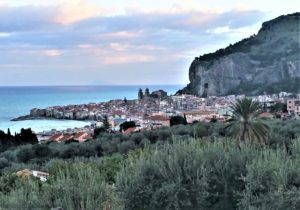 Cefalu is a dreamy village that sits beneath a craggy outcrop of rock facing a beautiful golden crescent beach. The old town has a Medieval character. It is best known for its Arab-Norman cathedral, a UNESCO World Heritage Site. The 12th Century fortress-like structure encloses a mixture of interiors, including re-purposed Ancient Roman Columns supported by newer Norman arches. A glittering gold Byzantine mosaic of Christ is the focal point of the altar, flanked by mosaics of the Madonna, the Apostles and Archangels. Lavatoio Medievale is a “medieval wash” house of Cefalu.
Cefalu is a dreamy village that sits beneath a craggy outcrop of rock facing a beautiful golden crescent beach. The old town has a Medieval character. It is best known for its Arab-Norman cathedral, a UNESCO World Heritage Site. The 12th Century fortress-like structure encloses a mixture of interiors, including re-purposed Ancient Roman Columns supported by newer Norman arches. A glittering gold Byzantine mosaic of Christ is the focal point of the altar, flanked by mosaics of the Madonna, the Apostles and Archangels. Lavatoio Medievale is a “medieval wash” house of Cefalu.
 Above the cathedral looms La Rocca—a large rock outcrop crowned by the rocky ruins of an old Norman castle. Getting to the top involves a 30-minute climb on a huge staircase, Salita Saraceni, from Cefalu’s Piazza Garibaldi. Those who brave the climb are rewarded by panoramic views of town. The old castle is mostly ruins.
Above the cathedral looms La Rocca—a large rock outcrop crowned by the rocky ruins of an old Norman castle. Getting to the top involves a 30-minute climb on a huge staircase, Salita Saraceni, from Cefalu’s Piazza Garibaldi. Those who brave the climb are rewarded by panoramic views of town. The old castle is mostly ruins.
Having dinner at night in Cefalu is a beautiful way to complete the tour of Sicily. Cefalu is an hour from Palermo (barring traffic problems) and is a perfect place to arise the next morning and head to the airport.


Leave a Comment